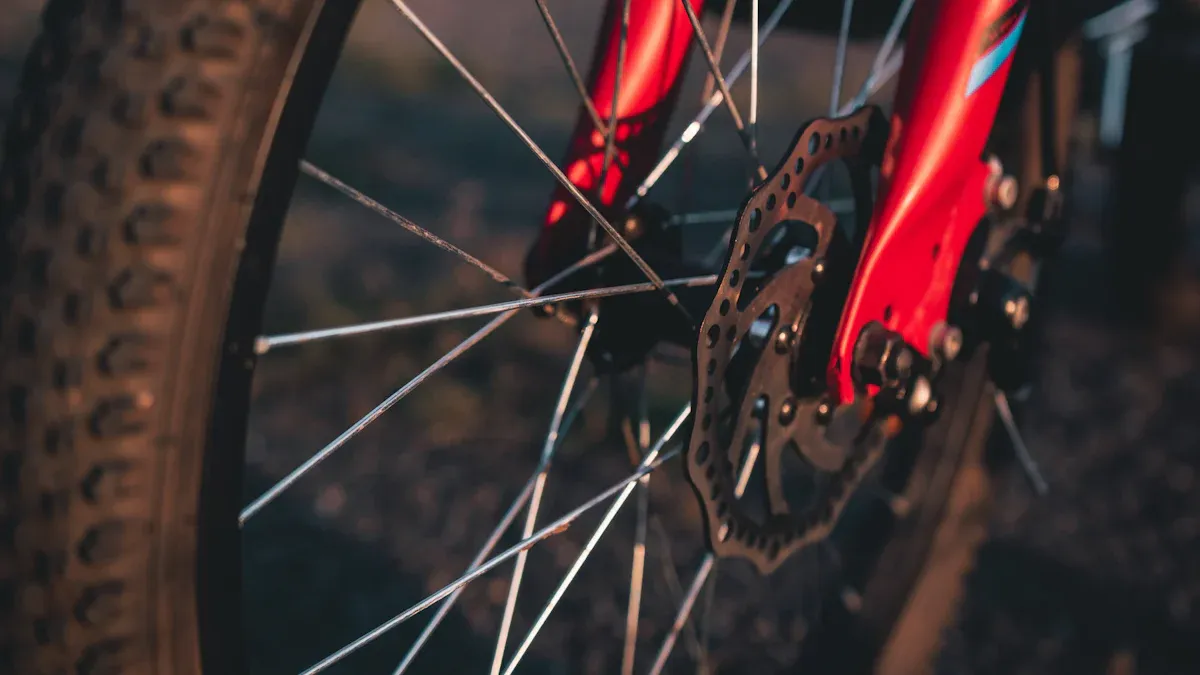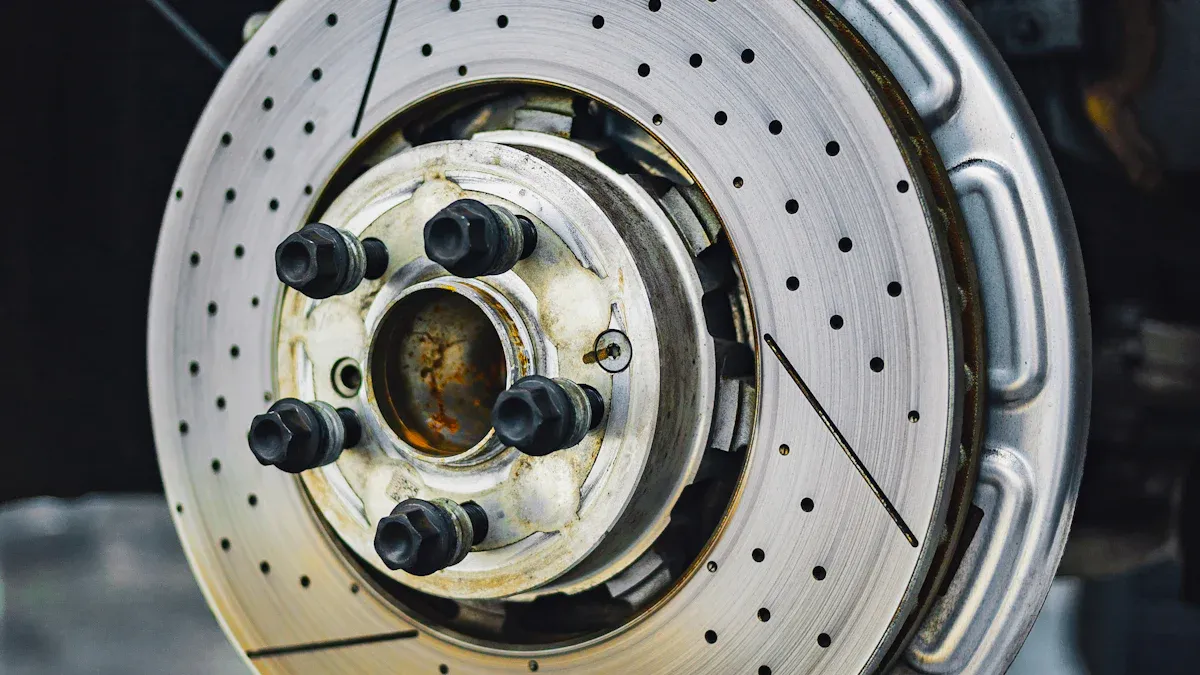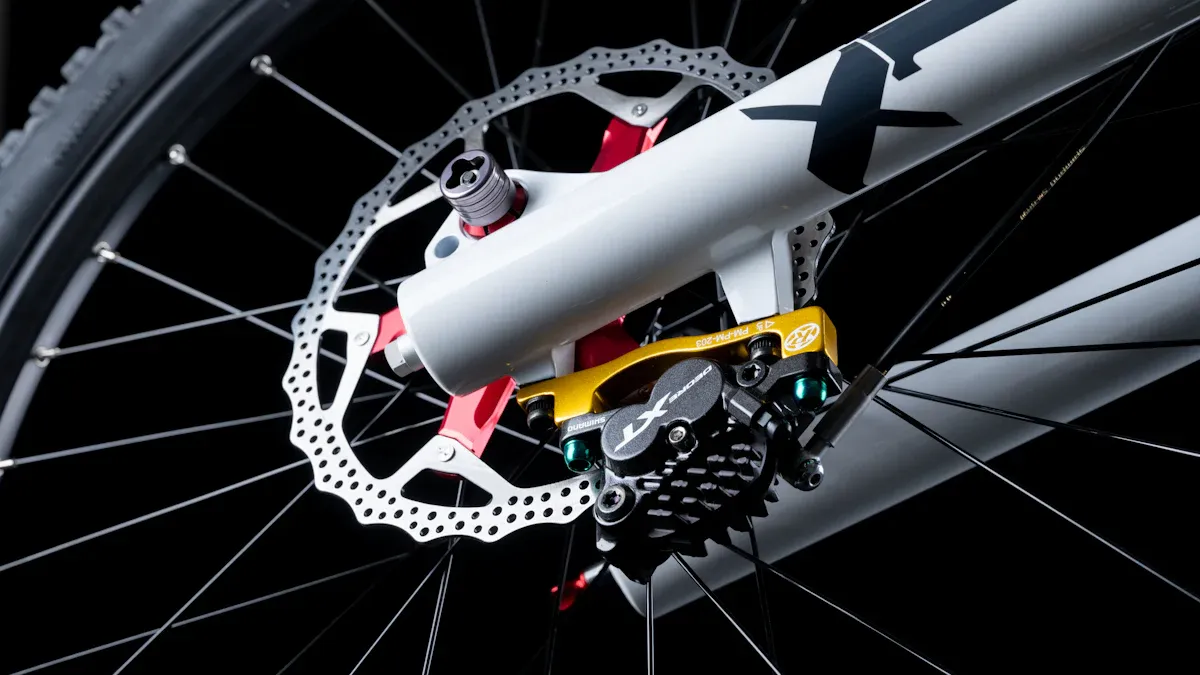
Choosing the right bike frame is very important. It affects your performance and safety on the road. More cyclists are choosing disk brake bike frames. They offer better stopping power and control. In the last ten years, technology has improved these bikes. New innovations like hydraulic disk brakes and carbon fiber rotors make them more attractive. When you look at your choices, think about frame materials, shape, and how they work with disk brake systems. This will help you find the best fit for you.
Key Takeaways
Picking the right bike frame is very important for how well you ride and your safety. Think about how you ride and what you need before you decide.
Mechanical disc brakes are cheap and easy to take care of, but they need more hand strength and might not work well when it’s wet.
Hydraulic disc brakes have better stopping power and need less care, so they are great for tough rides.
The material of the frame affects your ride. Aluminum is light and affordable, carbon fiber gives high performance, and steel is comfortable and strong.
Always check if the brakes and tires fit your bike to make sure it works for your riding needs.
Disc Brake Types

When you think about disc brakes, there are two main types: mechanical and hydraulic. Each type has its own benefits, so let’s look at them closely.
Mechanical Disc Brakes
Mechanical disc brakes are a popular choice for many riders. They use a cable system. When you pull the lever, it pushes the brake pads against the rotor. Here are some important facts about mechanical disc brakes:
Affordability: They usually cost less than hydraulic systems. This makes them a good choice for riders on a budget.
Ease of Maintenance: You can adjust them easily by yourself. This is great for touring or bikepacking when you might need repairs far from home.
Reliability: They work well in different conditions. But remember, they might need more adjustments because of dirt and alignment problems.
However, mechanical disc brakes have some downsides. They need more hand strength to use, especially on long downhill rides. In wet weather, they might not work as well, which can be unsafe.
Hydraulic Disc Brakes
On the other hand, hydraulic disc brakes give better performance. They use a sealed fluid system. This helps transfer force from the lever to the caliper. You get strong and steady braking with less effort. Here’s why many riders like hydraulic disc brakes:
Greater Stopping Power: Hydraulic systems usually provide 20-30% more stopping power than mechanical ones. This is helpful on steep hills.
Improved Modulation: Hydraulic brakes allow for smoother and more controlled stopping. This is important for tricky trails.
Less Maintenance: With a sealed system, hydraulic brakes collect less dirt. This makes them easier to take care of over time.
In tough conditions, hydraulic disc brakes keep 80-90% of their dry performance. Mechanical systems can drop to 60-70%. This difference can really change your riding experience.
Disk Brake Bike Frame Materials

Choosing a disc brake bike frame is important. The material affects how you ride. Each frame material has good and bad points. Let’s look at the three most common materials: aluminum, carbon fiber, and steel.
Aluminum Frames
Many cyclists like aluminum frames for a few reasons. They balance weight, stiffness, and cost well. Here are some benefits of aluminum frames:
Lightweight: Aluminum frames are lighter than steel. This makes them great for racing and climbing. You will notice the lighter weight on steep hills.
Cost-Effective: They usually cost less than carbon fiber frames. This makes them a good choice for riders on a budget.
Durability: Aluminum frames can handle a lot of wear. They might not last as long as carbon fiber. They can have metal fatigue over time, but they still perform well on rough terrain.
But remember, aluminum frames can be less comfy than steel or carbon fiber because they are stiffer.
Carbon Fiber Frames
Carbon fiber frames are popular for their great performance. Here’s why you might want a carbon fiber frame:
Superior Stiffness: Carbon fiber frames are very stiff. This helps transfer power when you ride. You get more energy from pedaling to the road.
Lightweight: They are the lightest of the three materials. They usually weigh between 900 to 1200 grams. This can really boost your cycling performance.
Vibration Damping: Special carbon techniques allow stiffness in key areas. This helps with comfort and absorbs vibrations in less important areas.
Carbon fiber frames cost more, but they give better braking and handling, especially in wet weather.
Steel Frames
Steel frames have a strong reputation among cyclists. Here’s why they are a good choice:
Comfort: Steel frames offer a unique ride. They feel ‘springy’ and reduce vibrations, making long rides more comfortable.
Durability: Steel lasts a long time. A well-kept steel bike can last forever. They are also easier to fix than aluminum or carbon frames.
Weight: Steel frames are heavier (1400 to 1900 grams). This extra weight can help with stability and comfort on bumpy roads.
But if you want a light bike for racing, steel might not be the best option.
Comparison Table
Here’s a quick look at the average weights of these frame materials:
Material | |
|---|---|
Carbon | 900 – 1000 |
1100 – 1200 (cheaper) | |
Steel | 1400 – 1600 (high-end) |
1600 – 1900 (cheaper) |
Frame Geometry and Fit
When you pick a disc brake bike frame, knowing frame geometry is very important. Geometry affects how your bike rides and how comfy you feel. A good frame design can make your ride better, whether you are racing or just riding around town.
Importance of Geometry
Different measurements in frame geometry are key to your bike’s performance. For example, the bottom bracket drop shows how low the bottom bracket is compared to the wheel axles. A lower drop can help with stability, especially when turning fast.
Here’s a quick look at some common frame geometry measurements:
Measurement | Description |
|---|---|
Bottom Bracket Drop | Shows how low the bottom bracket is compared to the wheel axles. |
Stem Length | Affects how far you reach and how the bike handles; changes based on bike type and rider choice. |
Handlebar Width | Affects aerodynamics and handling; measured ‘centre to centre’ or ‘outside to outside’. |
Handlebar Reach | Distance the bar goes forward from the clamp area; linked to stem length. |
Crank Length | Affects seat height and overall bike fit; usually between 170mm to 175mm. |
Seat Post | Includes measurements like seat tube length and saddle set back, which affect rider position. |
Remember, a stiffer frame can boost brake performance. Thicker thru axles, usually 12mm or 15mm, make a stronger link between the frame and wheels. This stiffness can help with handling but might also reduce flexibility, which is important for keeping a good line during sharp turns.
Riding Style Considerations
Your riding style should guide your choice of frame geometry. For instance, if you like racing, you may want a bike with a longer top tube and shorter head tube. This setup gives you a more aggressive riding position for better speed. But if you enjoy long rides, an endurance bike with a shorter top tube and longer head tube will give you a more upright and comfy position.
Here are some key factors to think about based on your riding style:
Race bikes: Longer top tube for speed.
Endurance bikes: Shorter top tube for comfort.
Trail bikes: Balanced geometry for stability and maneuverability.
Compatibility with Brake Systems
When you pick a disc brake bike frame, it’s very important to check if it works with brake systems. You need to make sure your frame can fit the type of disc brakes you want to use. Two main things to think about are mounting standards and tire clearance.
Mounting Standards
Disc brake systems have different mounting standards. Knowing these can help you choose the right one. The two most common types are post mount and flat mount. Here’s a quick look at how they compare:
Feature | Post Mount | Flat Mount |
|---|---|---|
Installation Process | Bolts directly to the frame or fork with M6x1 holes, easier to install. | Needs adapters for different rotor sizes, more complicated installation with specific bolt lengths. |
Performance Characteristics | Usually more mechanically efficient and strong. | Made for saving weight and aerodynamics, but may have space issues with adapters. |
Rotor Compatibility | Commonly supports 160mm front and rear, with various adapter options. | Mainly works with 140mm and 160mm rotors, with special designs for larger sizes. |
Adapter Complexity | Fewer adapters needed, with a simple setup. | More adapters needed, with possible compatibility problems between brands. |
Caliper Standard | Uses the same calipers for most uses, easier to switch. | A new caliper standard, which can cause problems when adapting to other systems. |
Risk of Damage | Threads in the frame can get damaged, but repairs are often possible. | More complex design may cause installation problems if not done right. |
Knowing these differences helps you find a frame that fits your braking needs. If you want an easy setup, post mount might be best. But if you want a lighter option, flat mount could work better.
Tire Clearance Considerations
Tire clearance is another key point when choosing a disc brake bike frame. You need to make sure your frame can fit the tire sizes you want to use. Wider tires can improve your ride by giving better grip and comfort. Here’s a look at the biggest tire sizes for different bike series:
Bike Series | Max Tire Size | Clearance Requirement |
|---|---|---|
Verza Speed Carbon | 28mm | 4mm |
VR series | 30mm (best), up to 34mm (depends on tire/rim) | 4mm |
Z (disc brake) series | 25mm (max), 27mm (might fit) | 4mm |
IA (disc brake) series | 28mm | N/A |
DA series | 25mm | N/A |
Breed and Broam series | 650b x 2.1 or 700c x 45c | N/A |
FX carbon (2015+) | 34mm | N/A |
MTB Compulsion | 2.6 ISO | N/A |
Tip: More tire clearance lets you use wider tires, which can improve comfort and grip. Wider tires soak up more road bumps and give better traction on rough paths, making your rides more fun.
By making sure your frame has enough tire clearance, you can enjoy better performance on different surfaces. This is especially helpful if you plan to ride on gravel or off-road trails.
Aesthetic Preferences
When you pick a disc brake bike frame, looks are just as important as how it rides. You want a bike that works well and looks good too. Let’s explore some important parts of aesthetic choices.
Color Choices
Color is a big part of how you feel about your bike. It’s not only about how it looks; it can change how you feel when you ride. Dain Zaffke from Giro Sport Design says that color is often the most important thing when buying a bike. A bright color can make you feel happy and help your bike stand out. For example, a brown accessory with a bright frame can make it look even better. So, think about what colors you like. Do you want bold colors or something more simple?
Customization Options
Customization lets you make your bike special. Many brands offer different ways to personalize your ride. Here’s a quick look at some common customization types:
Customization Type | Options |
|---|---|
Painting | Custom painting available, contact for requirements |
Frame Sizes | L, M, S, XL, XS |
Colors | Black, Chameleon, Custom paint, Red |
Custom paint jobs and stickers can also change how much your bike is worth later. A good paint job can make it look better and might raise its value. But a bad or too personal design might lower it. So, when customizing, think about how your choices will affect your bike in the future.
In the end, your bike should show your style and personality. Whether you want a classic look or something more fun, make sure it feels right for you!
Choosing the right disc brake bike frame has some important points to consider. First, think about what type of bike you need. This depends on your riding style, like mountain biking, road cycling, or city riding. Next, look at your budget and choose between mechanical and hydraulic disc brakes. Also, remember that good parts are important because they affect how well you can stop.
Take your time to look into and try different choices. Always check your bike before riding and take it for a test ride. This will help you see if it fits your needs. Don’t forget to check the return policies at bike shops. This can make you feel more sure about your purchase.
In the end, your bike should fit your personal needs and likes. Enjoy your ride!
FAQ
What are the benefits of disc brakes over traditional brakes?
Disc brakes offer better stopping power, especially in wet conditions. They provide consistent performance and require less hand strength, making them easier to use during long rides.
How do I know if my bike frame is compatible with disc brakes?
Check for mounting points on your frame. Look for either post mount or flat mount standards. Ensure your frame has enough tire clearance for the size of tires you want to use.
Can I upgrade my existing bike to disc brakes?
Yes, you can upgrade, but it depends on your current bike frame. Ensure your frame has the necessary mounts and clearance for disc brakes. You may also need new wheels and brake components.
How often should I maintain my disc brakes?
Regular maintenance is key. Check your brake pads and rotors for wear every few months. Clean the rotors and inspect the hydraulic system or cables to ensure everything functions smoothly.
What size rotors should I use for my bike?
Rotor size typically ranges from 140mm to 180mm. Your choice depends on your riding style and bike type. Larger rotors provide more stopping power, while smaller ones are lighter and better for climbing.
See Also
Selecting The Ideal Bike Frame Tailored To Your Requirements
Easily Determine The Perfect Size For Your Downhill Bike Frame
Finding The Best Step-Through Bike Frame For Your Preferences
Key Factors To Evaluate When Selecting An E-Mountain Bike Frame
